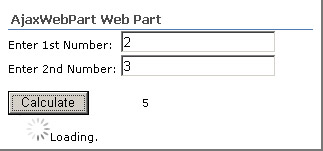
Introduction
This article describes how to build your first SharePoint 2007 Web part which supports ASP.NET 2.0 AJAX 1.0.
Software needed
- SharePoint Portal Server 2007 (installed with site collection created on port: 80)
- Visual Studio 2005
- Visual Studio 2005 Extensions for SharePoint 2007
- ASP.NET 2.0 AJAX 1.0
Using the code
First you need to configure your SharePoint Portal to support AJAX. To do this, it is better to open a new AJAX web site in Visual Studio to pick a copy from configuration sections in web.config, or you can copy from here, so let's start:
- Add the following part under:
<configSections>
<sectionGroup name="system.web.extensions"
type="System.Web.Configuration.SystemWebExtensionsSectionGroup,
System.Web.Extensions, Version=1.0.61025.0, Culture=neutral,
PublicKeyToken=31bf3856ad364e35">
<sectionGroup name="scripting"
type="System.Web.Configuration.ScriptingSectionGroup,
System.Web.Extensions, Version=1.0.61025.0, Culture=neutral,
PublicKeyToken=31bf3856ad364e35">
<section name="scriptResourceHandler"
type="System.Web.Configuration.ScriptingScriptResourceHandlerSection,
System.Web.Extensions, Version=1.0.61025.0, Culture=neutral,
PublicKeyToken=31bf3856ad364e35" requirePermission="false"
allowDefinition="MachineToApplication"/>
<sectionGroup name="webServices"
type="System.Web.Configuration.ScriptingWebServicesSectionGroup,
System.Web.Extensions, Version=1.0.61025.0, Culture=neutral,
PublicKeyToken=31bf3856ad364e35">
<section name="jsonSerialization"
type="System.Web.Configuration.ScriptingJsonSerializationSection,
System.Web.Extensions, Version=1.0.61025.0, Culture=neutral,
PublicKeyToken=31bf3856ad364e35" requirePermission="false"
allowDefinition="Everywhere" />
<section name="profileService"
type="System.Web.Configuration.ScriptingProfileServiceSection,
System.Web.Extensions, Version=1.0.61025.0, Culture=neutral,
PublicKeyToken=31bf3856ad364e35" requirePermission="false"
allowDefinition="MachineToApplication" />
<section name="authenticationService"
type="System.Web.Configuration.ScriptingAuthenticationServiceSection,
System.Web.Extensions, Version=1.0.61025.0, Culture=neutral,
PublicKeyToken=31bf3856ad364e35" requirePermission="false"
allowDefinition="MachineToApplication" />
</sectionGroup>
</sectionGroup>
</sectionGroup>
- Add the following part under:
<pages>
<controls>
<add tagPrefix="asp" namespace="System.Web.UI"
assembly="System.Web.Extensions, Version=1.0.61025.0,
Culture=neutral, PublicKeyToken=31bf3856ad364e35" />
</controls>
- Add the following part under :
<compilation><assemblies>
<add assembly="System.Web.Extensions, Version=1.0.61025.0,
Culture=neutral, PublicKeyToken=31bf3856ad364e35" />
- Add the following part under:
<httpHandlers>
<add verb="*" path="*.asmx" validate="false"
type="System.Web.Script.Services.ScriptHandlerFactory,
System.Web.Extensions, Version=1.0.61025.0, Culture=neutral,
PublicKeyToken=31bf3856ad364e35"/>
<add verb="*" path="*_AppService.axd" validate="false"
type="System.Web.Script.Services.ScriptHandlerFactory,
System.Web.Extensions, Version=1.0.61025.0, Culture=neutral,
PublicKeyToken=31bf3856ad364e35"/>
<add verb="GET,HEAD" path="ScriptResource.axd"
type="System.Web.Handlers.ScriptResourceHandler,
System.Web.Extensions, Version=1.0.61025.0, Culture=neutral,
PublicKeyToken=31bf3856ad364e35" validate="false"/>
- Add the following part under:
<httpModules>
<add name="ScriptModule" type="System.Web.Handlers.ScriptModule,
System.Web.Extensions, Version=1.0.61025.0, Culture=neutral,
PublicKeyToken=31bf3856ad364e35"/>
- At the end of web.config add the following part under:
<configuration>
<system.web.extensions>
<scripting>
<webServices>
<!-- Uncomment this line to enable the authentication service.
Include requireSSL="true" if appropriate. -->
<!--
<authenticationService enabled="true" requireSSL = "true|false"/>
-->
<!-- Uncomment these lines to enable the profile service.
To allow profile properties to be retrieved and
modified in ASP.NET AJAX applications,
you need to add each property name to the readAccessProperties
and writeAccessProperties attributes. -->
<!--
<profileService enabled="true"
readAccessProperties="propertyname1,propertyname2"
writeAccessProperties="propertyname1,propertyname2" />
-->
</webServices>
<!--
<scriptResourceHandler enableCompression="true"
enableCaching="true" />
-->
</scripting>
</system.web.extensions>
<system.webServer>
<validation validateIntegratedModeConfiguration="false"/>
<modules>
<add name="ScriptModule" preCondition="integratedMode"
type="System.Web.Handlers.ScriptModule, System.Web.Extensions,
Version=1.0.61025.0, Culture=neutral,
PublicKeyToken=31bf3856ad364e35"/>
</modules>
<handlers>
<remove name="WebServiceHandlerFactory-Integrated" />
<add name="ScriptHandlerFactory" verb="*" path="*.asmx"
preCondition="integratedMode"
type="System.Web.Script.Services.ScriptHandlerFactory,
System.Web.Extensions, Version=1.0.61025.0, Culture=neutral,
PublicKeyToken=31bf3856ad364e35"/>
<add name="ScriptHandlerFactoryAppServices"
verb="*" path="*_AppService.axd" preCondition="integratedMode"
type="System.Web.Script.Services.ScriptHandlerFactory,
System.Web.Extensions, Version=1.0.61025.0, Culture=neutral,
PublicKeyToken=31bf3856ad364e35"/>
<add name="ScriptResource" preCondition="integratedMode"
verb="GET,HEAD" path="ScriptResource.axd"
type="System.Web.Handlers.ScriptResourceHandler,
System.Web.Extensions, Version=1.0.61025.0, Culture=neutral,
PublicKeyToken=31bf3856ad364e35" />
</handlers>
</system.webServer>
- Before closing web.config we should add the AJAX controls dll to SharePoint Safe Controls, so copy the following part under:
<SafeControls>
<SafeControl Assembly="System.Web.Extensions, Version=1.0.61025.0,
Culture=neutral, PublicKeyToken=31bf3856ad364e35"
Namespace="System.Web.UI" TypeName="*" Safe="True" />
- It is time to include the AJAX script Manager to the master page. In my case, I've included the script manager control in the default.master located in the following path: C:\Program Files\Common Files\Microsoft Shared\web server extensions\12\TEMPLATE\GLOBAL
So, according to your portal template; locate the right master page file or you can open the master page from the SharePoint Designer under _catalogs folder. After you locate the master page file, open the file then put the following line inside the top of <form> tag.
<asp:ScriptManager runat="server" ID="ScriptManager1">
</asp:ScriptManager>
As shown below:
<form runat="server" onsubmit="return _spFormOnSubmitWrapper();">
<WebPartPages:SPWebPartManager id="m" runat="Server" />
<asp:ScriptManager runat="server" ID="ScriptManager1">
</asp:ScriptManager>
<TABLE class="ms-main" CELLPADDING=0 CELLSPACING=0 BORDER=0
WIDTH="100%" HEIGHT="100%">
- Finally it is time to write our code. Open a new web part project from Visual Studio 2005, then add a reference of System.Web.Extensions to the project and write the following code to web part code file:
Note: There is a SharePoint Script included for changing the form action which may stop the form submission, so I included the FixFormAction method which will reset the form action again
using System;
using System.Runtime.InteropServices;
using System.Web.UI;
using System.Web.UI.WebControls;
using System.Web.UI.WebControls.WebParts;
using System.Xml.Serialization;
using Microsoft.SharePoint;
using Microsoft.SharePoint.WebControls;
using Microsoft.SharePoint.WebPartPages;
namespace AjaxWebPart
{
[Guid("733ee261-6e34-49cf-ae29-e8aeb4df4563")]
public class AjaxWebPart : System.Web.UI.WebControls.WebParts.WebPart
{
public AjaxWebPart()
{
this.ExportMode = WebPartExportMode.All;
}
private Label label;
private Label label2;
private Label label3;
private TextBox textBox1;
private TextBox textBox2;
protected UpdatePanel udatePanel;
protected UpdateProgress updateProgress;
protected override void CreateChildControls()
{
base.CreateChildControls();
this.FixFormAction();
udatePanel = new UpdatePanel();
updateProgress = new UpdateProgress();
udatePanel.ID = "_UpdatePanel";
updateProgress.ID = "_UpdateProgress";
string templateHTML =
"<div><img alt=
\"Loading...\" src=\"/_layouts/images/loader.gif\"/>
Loading...</div>";
updateProgress.ProgressTemplate =
new ProgressTemplate(templateHTML);
updateProgress.AssociatedUpdatePanelID = udatePanel.ClientID;
udatePanel.UpdateMode = UpdatePanelUpdateMode.Conditional;
this.Controls.Add(udatePanel);
this.label = new Label();
this.label2 = new Label();
this.label3 = new Label();
this.label.Text = "Enter 1st Number: ";
this.label2.Text = "Enter 2nd Number: ";
this.textBox1 = new TextBox();
this.textBox1.ID = "TextBox1";
this.textBox2 = new TextBox();
this.textBox2.ID = "TextBox2";
udatePanel.ContentTemplateContainer.Controls.Add(this.label);
udatePanel.ContentTemplateContainer.Controls.Add
(this.textBox1);
udatePanel.ContentTemplateContainer.Controls.Add
(new LiteralControl("<br />"));
udatePanel.ContentTemplateContainer.Controls.Add(this.label2);
udatePanel.ContentTemplateContainer.Controls.Add
(this.textBox2);
udatePanel.ContentTemplateContainer.Controls.Add
(new LiteralControl("<br /><br />"));
Button button = new Button();
button.Text = "Calculate";
button.Click += new EventHandler(HandleButtonClick);
udatePanel.ContentTemplateContainer.Controls.Add(button);
udatePanel.ContentTemplateContainer.Controls.Add
(new LiteralControl(" "));
udatePanel.ContentTemplateContainer.Controls.Add(this.label3);
udatePanel.ContentTemplateContainer.Controls.Add
(updateProgress);
}
private void HandleButtonClick(object sender, EventArgs eventArgs)
{
System.Threading.Thread.Sleep(1000);
this.label3.Text = Convert.ToString(int.Parse(textBox1.Text)
+ int.Parse(textBox2.Text));
}
private void FixFormAction ()
{
if (this.Page.Form != null)
{
string formOnSubmitAtt =
this.Page.Form.Attributes["onsubmit"];
if(formOnSubmitAtt == "return _spFormOnSubmitWrapper();")
{
this.Page.Form.Attributes["onsubmit"] =
"_spFormOnSubmitWrapper();";
}
}
ScriptManager.RegisterStartupScript
(this, typeof(AjaxWebPart), "UpdatePanelFixup",
"_spOriginalFormAction = document.forms[0].action;
_spSuppressFormOnSubmitWrapper=true;", true);
}
}
public class ProgressTemplate : ITemplate
{
private string template;
public ProgressTemplate(string temp)
{
template = temp;
}
public void InstantiateIn(Control container)
{
LiteralControl ltr = new LiteralControl(this.template);
container.Controls.Add(ltr);
}
}
}
Then build the solution and deploy the web part from Visual Studio to your portal. As you see, it is a simple web part to calculate the summation of two integers.
Be sure that Visual Studio has restarted your IIS and after that, browse the MOSS portal and Add AjaxWebPart from the web part gallery.
